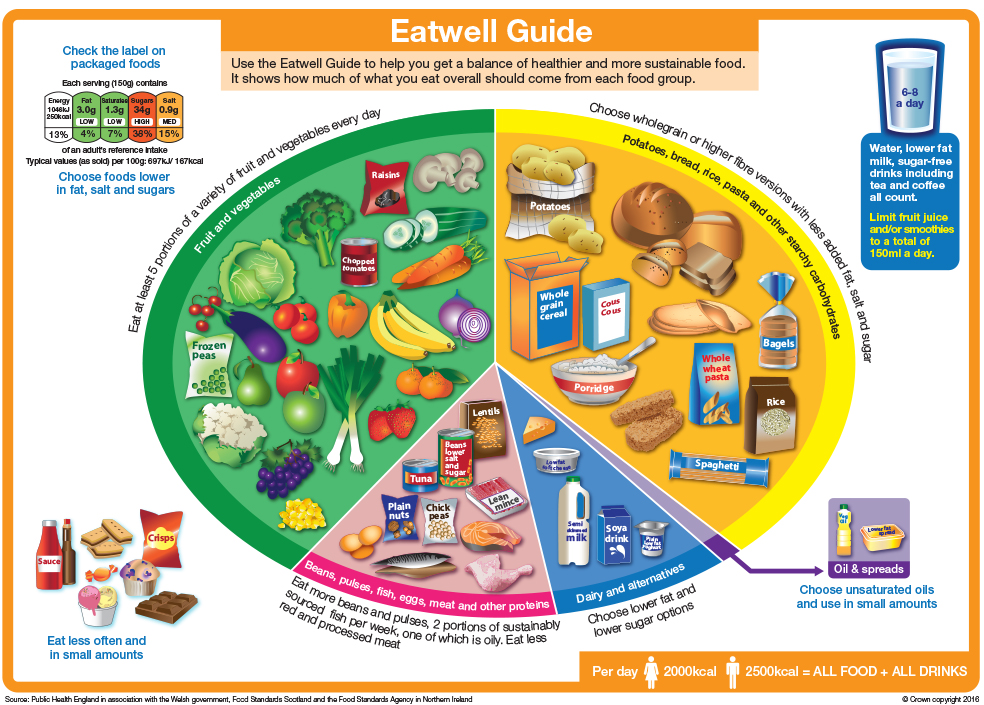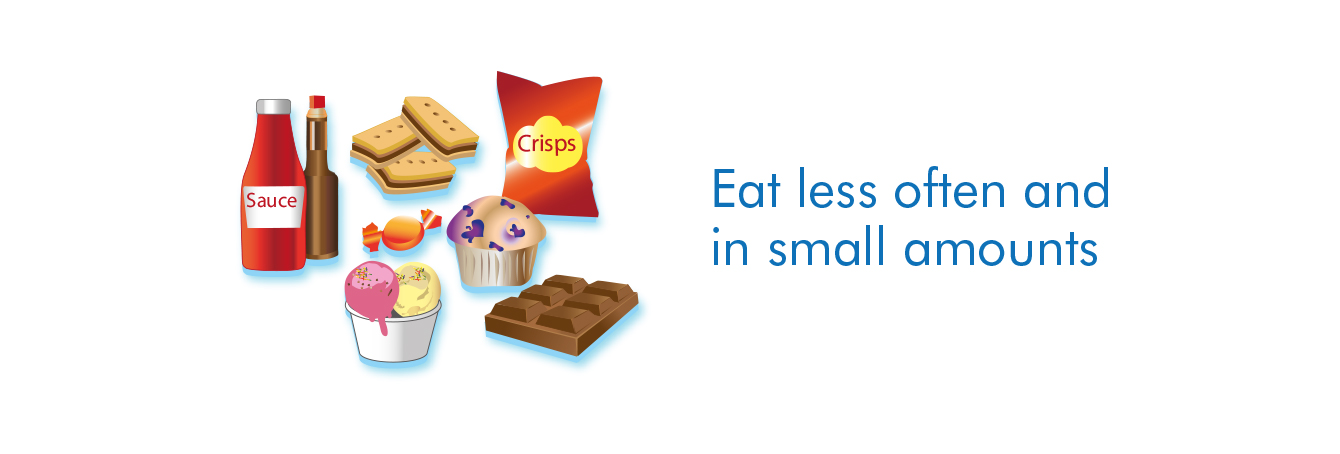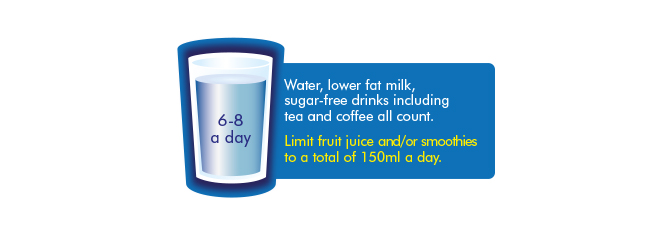Healthy Eating Tutorial
Introduction

By the end of this module you will:
- Be familiar with the food groups of the Eatwell Guide and how they relate to a healthy diet.
- Know the key healthy eating messages and be able to explain these using the Eatwell Guide.
Eatwell Guide
The Eatwell Guide illustrates the balance of different food groups required for a healthy diet. It was developed by experts based on scientific evidence. Eating a diet closer to the Eatwell Guide will help us meet our Dietary Goals in Scotland.
Here are some key points to consider for the Eatwell Guide:
- The Eatwell Guide includes five main food and drink groups, and applies to most people over the age of two, whatever their weight, ethnicity, dietary restrictions or preferences.
- We all need energy (calories) for our bodies to function.
- The right amount of calories from food and drinks will help you stay a healthy weight.
- How many calories an individual needs depends on their sex, weight, height and physical activity.
- The average female needs around 2,000 calories each day, while the average male needs around 2,500 calories each day. Young children need fewer calories than this.
- The aim is to get the right number of calories over the right period of time, such as a day or a week and not necessarily at every meal.
Anyone with special dietary requirements or medical needs may want to check with a registered dietitian on how to adapt the Eatwell Guide to meet their individual needs.
In the next few sections of this module, we will explore the different food groups that make up the Eatwell Guide in more detail.

View a larger version of this image
Also available is the Eatwell Guide Booklet.
Fruits and vegetables

Fruits and vegetables should make up just over a third of the food we eat; we should aim for at least 5 portions of a variety of fruit and vegetables each day. Fresh, frozen, tinned, dried or juiced fruits and vegetables all count towards your five a day.
Fruits and vegetables contain important vitamins, minerals and fibre. Vitamins and minerals help to prevent deficiency diseases whilst fibre can help lower cholesterol, improve gut health and aid digestion. Fruits and vegetables are low in fat and add bulk to the meal, keeping you fuller for longer without adding too many calories.
One portion would be 80g of fruit or vegetables, such as:
- 1 whole large fruit such as a banana, apple, pear or orange;
- 2 or more small fruits, for example 2 satsumas or plums;
- 3 heaped tablespoons of cooked or fresh vegetables such as peas or carrots;
- 7 (about a handful) strawberries or cherry tomatoes;
- A desert bowl of salad.
The following also count towards your five a day:
- A small glass (150ml) of either fruit juice or smoothie counts as a maximum of one portion per day due to their high sugar content;
- 1 tablespoon of dried fruit such as raisins (approximately 30g) – aim to keep these at mealtimes only;
- 80g of beans and pulses counts as a maximum of one portion per day because although they are a good source of fibre, they contain fewer nutrients than other fruits and vegetables.
Potatoes, bread, rice, pasta and other starchy carbohydrates
Potatoes, bread, rice, pasta and other starchy foods are a really important part of a healthy diet and should make up just over a third of the food we eat. They contain carbohydrates which provide the calories required to carry out every day activities as well as providing vitamins and minerals essential for health.
Gram for gram, starchy carbohydrates contain less than half the calories of fat with approximately 4 calories per gram of carbohydrate. However, some starchy food products can be high in fats and/or sugar from the way they are cooked or from ingredients added during production, e.g. chips or cheesy bread. Check the food labels for healthier options and minimise the addition of sources of fats and sugars e.g. ketchup or butter, when preparing them at home.
Cooking methods can also help minimise the fat content of starchy foods by choosing to boil or steam them instead of frying or roasting.
Wholegrain varieties of starchy foods contain more fibre and nutrients than white or refined starchy versions. Foods high in fibre are digested at a slower rate meaning they help keep us feeling full for longer.
Fibre can also help:
- Lower cholesterol, which can protect against heart disease;
- Bowel health;
- Digestion.
Examples of wholegrain carbohydrates include:
- Wholemeal and wholegrain bread, pitta and chapatti
- Whole-wheat pasta
- Brown rice
- Wholegrain breakfast cereals e.g. wheat biscuits
- Whole oats
There are also high-fibre white bread and pasta options available, such as 50/50 varieties of bread.
Dairy and alternatives

Dairy and alternatives are good sources of protein and vitamins, and they're also an important source of calcium. Calcium is important for healthy bones and teeth.
Some milk and dairy foods can be high in fat, saturated fat and sugar but there are plenty of low-fat and low-sugar options to choose from. For example, 1% fat milk contains about half the fat of semi-skimmed milk without a noticeable change in taste or texture.
Try to include some milk and dairy food (or dairy alternatives), such as cheese, yoghurt and fromage frais in your diet. Choose lower sugar and lower fat products where possible, or have a smaller amount of the full fat/sugar varieties less often.
Some people do not eat dairy foods, however there are plenty of dairy alternatives available to buy including soya drinks and yoghurts. If choosing plant based dairy alternatives, look for products that are unsweetened and have added calcium (often called "fortified"). Most dairy alternative products which are organic are not calcium-fortified.
Dairy substitutes and alternatives, such as soya, oat, nut or rice milks, often have added vitamins and minerals. However, these can be high in sugar and salt, so it is helpful to check the label and choose those that are lower.
Beans, pulses, fish, eggs, meat and other proteins

There are many different sources of protein in a healthy balanced diet, and these sources can also provide important vitamins, minerals and fibre. Some foods from this group should be eaten every day.
Pulses, such as beans, peas and lentils are naturally low in fat but high in fibre, protein, vitamins and minerals, and therefore make good alternatives to meat. Other vegetable based sources of protein include tofu, bean curd, Quorn and mycoprotein (found in many vegetarian products).
Aim for at least two portions (2 x 140g) of fish a week, including 1 portion of oil-rich fish. Oil-rich fish e.g. salmon, mackerel, tuna and herring contain important unsaturated omega 3 fats that protect against heart disease.
Red meat includes beef, lamb, venison and pork, all of which can form part of a healthy diet. Processed meat is meat that has been preserved by smoking, curing, salting or adding preservatives. Processed meat includes things like sausages, bacon, burgers, ham, salami, other cured meats and pâté. Some meats can be high in fat and saturated fats, but there are plenty of leaner cuts e.g. skinless chicken, turkey and extra lean mince, as well as meat substitutes to choose from. Processed meats are also often high in salt.
Whilst consumption of red and processed meat provides protein and other nutrients, eating lots can increase the risk of bowel cancer. The daily average intake of red or processed meat for adults should be no more than 70g a day, which is around two slices of roast meat or one average pork sausage.
Cooking methods can also help to cut down the fat content of meat and fish by cutting visible fat off and removing skin where possible, and opting for grilling or baking instead of frying.
Eggs are another good source of protein and there’s no limit on the number of eggs you can eat in a week. They are inexpensive and are great for making healthy, quick dishes like omelettes. Similarly, boiling or poaching an egg instead of frying it will also cut down on the fat content when cooking.
Many meat alternatives, such as tofu, mycoprotein (such as Quorn) and tempeh are all good sources of protein. However, vegetarians and vegans will need to ensure that they are eating a variety of different protein sources which are used to build and repair the body’s cells.
Oils and spreads

Although some fat in the diet is essential, many of us are eating too much and need to reduce our consumption. Unsaturated liquid oils and unsaturated spreads are healthier than saturated fats (see module 2 for more information on saturated fats) as they help to reduce cholesterol (high cholesterol levels can increase risk of heart disease and stroke), so it is important to get most of our fat from unsaturated sources. Examples of oils high in unsaturated fats include vegetable oil, rapeseed oil and olive oil. Also choosing lower-fat spreads, such as vegetable spreads, instead of butter is a good way to reduce intake of saturated fat.
Unsaturated fats tend to be liquid at room temperature, e.g. olive oil and rapeseed oil, whereas saturated fats tend to be solid at room temperature e.g. butter, ghee and coconut oil.
All types of fat (saturated and unsaturated) are high in calories, with 9 calories per gram of fat and therefore should only be consumed in small amounts. In comparison, carbohydrates contain less than half the calories of fat.
Foods and drinks high in fat, salt and sugars

Discretionary food and drink are most commonly high in fat, sugar and salt. They include confectionery, cakes, biscuits, pastries and savoury snacks, in addition to sugary drinks and drinks containing alcohol. These products tend to be high in calories, low in nutritional value and are not necessary for our health. Therefore they should only be eaten occasionally and in small amounts.
These foods contribute unnecessary calories which can contribute to weight gain if eaten regularly. Sugary foods and drinks can cause tooth decay, with over-consumption of sugary drinks in particular being associated with a higher risk of developing type 2 diabetes.
Check the label (covered in Module 3) and try to limit consumption of foods and drink which are high in fat, sugar and salt.
Salt
Only a very small amount of salt is needed in the diet, but two-thirds of adults in Scotland eat too much salt and would benefit from cutting down. Eating too much salt can raise blood pressure which can lead to stroke or heart disease.
Most of the salt in the Scottish diet comes from processed foods like bread, meat products, biscuits and ready meals, so adding extra salt at meal times is often unnecessary and can be harmful to health.
Adults should eat no more than 6g of salt per day (equivalent to about 1 teaspoon). Children’s diet should contain less salt than adults, with a maximum of between 2g – 6g of salt per day dependent on their age.
Tips to reducing salt intake:
- Check labels for foods and try choosing the lower salt varieties
- Taste food before adding salt
- Try replacing salt with pepper, herbs and spices to add to dishes
Hydration

The body constantly loses fluid through breathing, sweating and going to the toilet. Aim to drink 6-8 glasses of fluid each day to help keep the body hydrated.
Water, lower fat milk and sugar-free drinks, including tea and coffee all count. Choose sugar-free options instead of sugary drinks. Fruit juice and smoothies count towards your fluid consumption, but these are high in free sugars (sugars that are added to foods) and so should be limited to no more than 150ml per day.
Alcohol
To minimise the health risks associated with drinking alcohol, consumption should be limited to no more than 14 units per week for men and women. One unit is the same as one small single measure of spirits, while a 175ml glass of wine or a pint of standard strength lager or cider contains 2 units.
The amount of calories in an alcoholic drink depends on the type of alcohol, the amount served, and what mixers are added. As a general guide, 1 pint of 5% strength beer contains about 239 calories, a 175ml glass of 12% wine contains around 133 calories, and a double measure (50ml) of 40% gin contains around 95 calories.
Vegetarian and Vegan Diets’
A healthy diet for vegetarians and vegans is the same as for anyone else, but without meat or fish (or any foods that come from animals including dairy products and eggs for vegans). A healthy vegetarian or vegan diet can be achieved by following the Eatwell Guide (see Module 1 for more detail):
- Try to eat at least 5 portions of fruit and vegetables each day
- Base meals on starchy carbohydrates such as potatoes, bread and pasta (choose wholegrain varieties where possible)
- Dairy or dairy alternatives are needed for calcium, with lower-fat and lower-sugar alternatives being the healthier choice
- Protein can be found from foods such as beans, pulses and eggs
- Choose unsaturated oils and spreads
- Limit foods high in fat, sugar and salt
If not planned properly, vegetarian and diets can lack certain nutrients including iron, vitamin B12 and omega-3 fatty acids, as well as iodine, calcium and vitamin D for vegan diets.
Vitamins and minerals
All vitamins and many minerals are essential for health, and are required in small amounts by the body to work properly.
Most people should get the nutrients they need through a varied and balanced diet, with the exception of Vitamin D. Good dietary sources of vitamins and minerals include:
- Vitamin A – Cheese, eggs and oily fish.
- B Vitamins – Meat, fish, eggs and fortified breakfast cereals (depending on the type of B-vitamin).
- People who are pregnant or thinking of having a baby should take an additional 0.4mg of Vitamin B9 (Folic Acid) supplement daily from the time they stop using contraception until the 12th week of pregnancy.
- Vitamin B12 is mainly found in animal sources such as meat, fish and dairy products, and so Vitamin B12 supplements may be required for vegetarians and vegans.
- Vitamin C – Citrus fruits (such as oranges and grapefruit), broccoli and peppers.
- Calcium – Dairy (milk and yogurt), green leafy vegetables and soya drinks with added calcium.
- Iodine – Saltwater fish (including cod and haddock), and shellfish.
- Iron – Liver, red meat and beans e.g. red kidney beans and chickpeas.
Vitamin D
Our main source of vitamin D is sunlight. In Scotland, we only get enough of the right kind of sunlight for our bodies to make Vitamin D between April and September, mostly between 11 am and 3 pm. From October to March, we need to rely on dietary sources of Vitamin D. Since Vitamin D is found only in a small number of foods, it might be difficult to get enough from foods that naturally contain Vitamin D and/or fortified foods alone.
Everyone (including children) should consider taking a daily supplement containing 10 micrograms of Vitamin D, particularly between October – March.
Summary

What is a healthy diet?
The Eatwell Guide illustrates the balance of a healthy diet and includes:
- Meals based on potatoes, bread, rice, pasta or other starchy carbohydrates and using wholegrain versions wherever possible.
- Eating at least 5 portions of a variety of fruit and vegetables every day.
- Eating some beans, pulses, fish, eggs, meat and other proteins; including 2 portions of fish every week, one of which should be oil rich.
- Eating some dairy or dairy alternatives and choose lower fat and sugar options.
- Eating only a small amount of oils and spreads.
- Drinking 6-8 cups/glasses of fluid a day.
- Eating discretionary foods and drinks less often and in smaller amounts.
- Checking product labels to help you choose lower salt varieties.
Module 2 quiz
Answer the questions below to see what you've learned and to complete module 2.
-
Pick the best source of fibre from the following options.
Choose 1 answer
CorrectIncorrect -
Which statement is false about dairy and alternatives?
Choose 1 answer
CorrectIncorrect -
Some meats can be high in fat and saturated fat.
Choose 1 answer
CorrectIncorrect
You completed Module 2 – complete all modules to progress.
Back to overview